Workplace Behavior: Determinants Analysis for Ceylon Biscuits Limited
VerifiedAdded on 2020/03/01
|8
|1713
|97
Report
AI Summary
This report delves into the determinants of workplace behavior, with a specific focus on Ceylon Biscuits Limited (CBL). It explores the challenges of deviant and unethical behaviors, highlighting the impact of factors such as workplace norms and antisocial approaches. The literature review examines CBL's core values, organizational structure, and the concept of workplace deviance. The report also introduces the Affective Events Theory (AET), explaining how emotions and moods influence job performance and satisfaction. It analyzes how various work models and events can affect employees' emotional responses and, consequently, their behavior. The study also evaluates theoretical hypotheses and the relationship between workplace behavior and day-to-day work interactions. The report concludes with a discussion of the interpersonal affectivity within organizations and its impact on deviant behavior. The reference section provides a list of relevant sources used in the report.
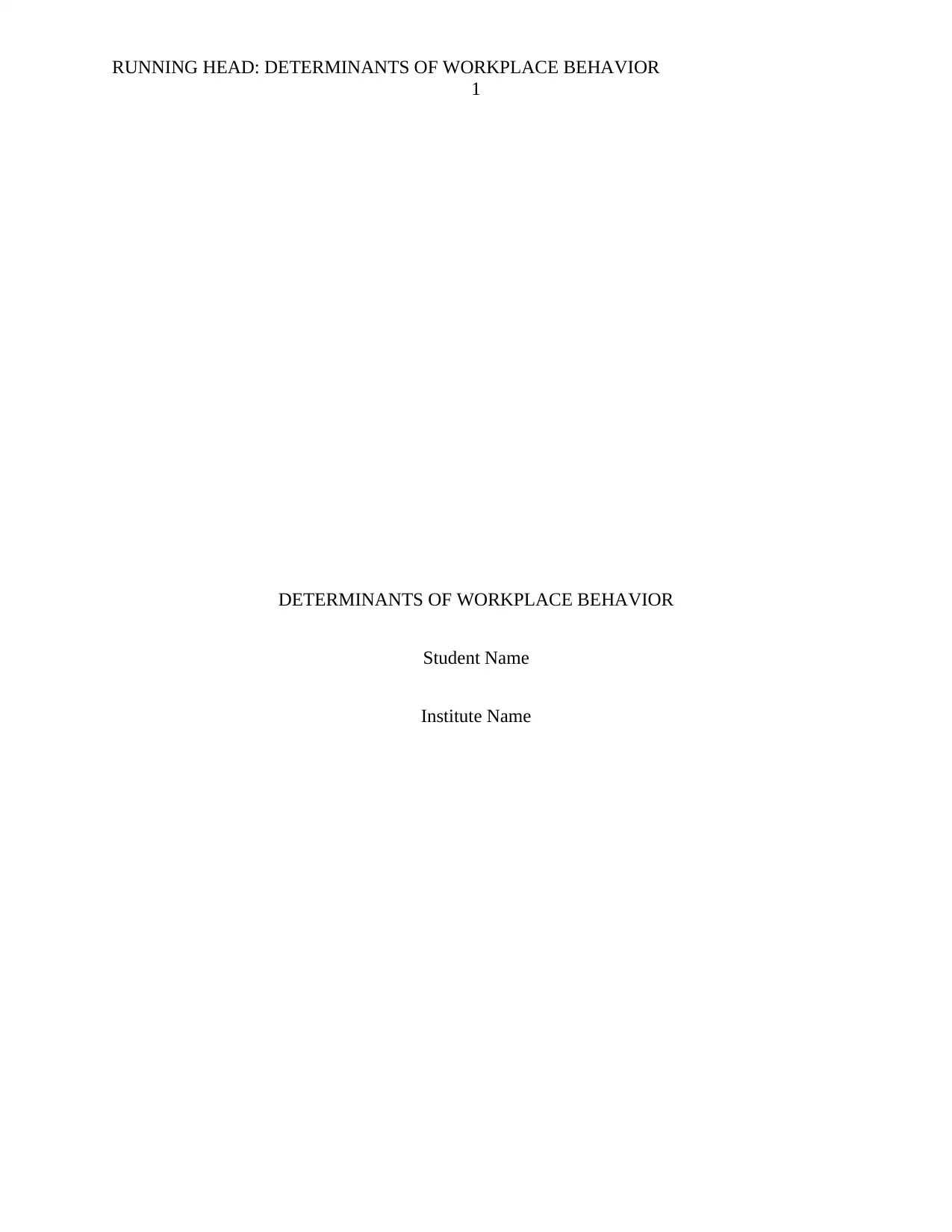
RUNNING HEAD: DETERMINANTS OF WORKPLACE BEHAVIOR
1
DETERMINANTS OF WORKPLACE BEHAVIOR
Student Name
Institute Name
1
DETERMINANTS OF WORKPLACE BEHAVIOR
Student Name
Institute Name
Paraphrase This Document
Need a fresh take? Get an instant paraphrase of this document with our AI Paraphraser
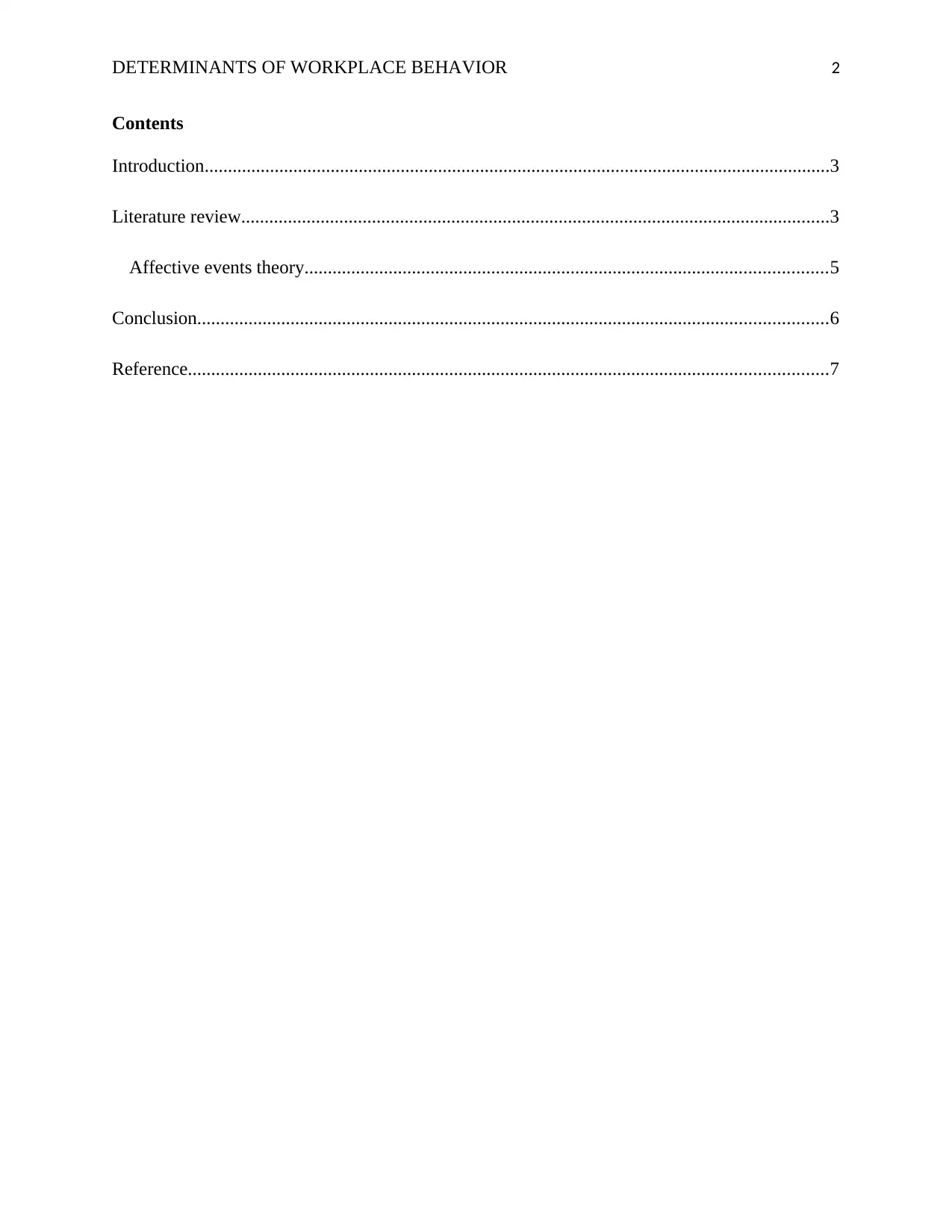
DETERMINANTS OF WORKPLACE BEHAVIOR 2
Contents
Introduction......................................................................................................................................3
Literature review..............................................................................................................................3
Affective events theory................................................................................................................5
Conclusion.......................................................................................................................................6
Reference.........................................................................................................................................7
Contents
Introduction......................................................................................................................................3
Literature review..............................................................................................................................3
Affective events theory................................................................................................................5
Conclusion.......................................................................................................................................6
Reference.........................................................................................................................................7
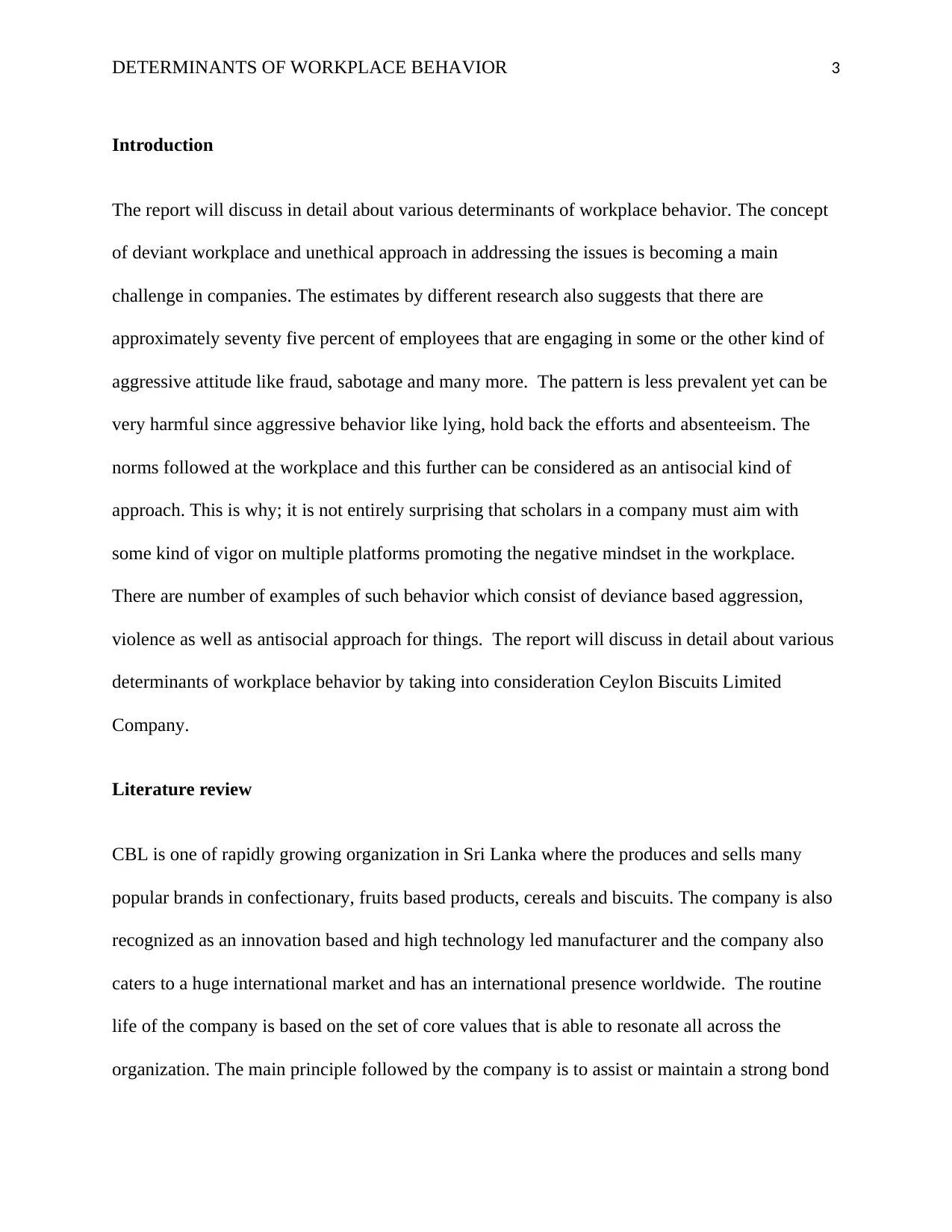
DETERMINANTS OF WORKPLACE BEHAVIOR 3
Introduction
The report will discuss in detail about various determinants of workplace behavior. The concept
of deviant workplace and unethical approach in addressing the issues is becoming a main
challenge in companies. The estimates by different research also suggests that there are
approximately seventy five percent of employees that are engaging in some or the other kind of
aggressive attitude like fraud, sabotage and many more. The pattern is less prevalent yet can be
very harmful since aggressive behavior like lying, hold back the efforts and absenteeism. The
norms followed at the workplace and this further can be considered as an antisocial kind of
approach. This is why; it is not entirely surprising that scholars in a company must aim with
some kind of vigor on multiple platforms promoting the negative mindset in the workplace.
There are number of examples of such behavior which consist of deviance based aggression,
violence as well as antisocial approach for things. The report will discuss in detail about various
determinants of workplace behavior by taking into consideration Ceylon Biscuits Limited
Company.
Literature review
CBL is one of rapidly growing organization in Sri Lanka where the produces and sells many
popular brands in confectionary, fruits based products, cereals and biscuits. The company is also
recognized as an innovation based and high technology led manufacturer and the company also
caters to a huge international market and has an international presence worldwide. The routine
life of the company is based on the set of core values that is able to resonate all across the
organization. The main principle followed by the company is to assist or maintain a strong bond
Introduction
The report will discuss in detail about various determinants of workplace behavior. The concept
of deviant workplace and unethical approach in addressing the issues is becoming a main
challenge in companies. The estimates by different research also suggests that there are
approximately seventy five percent of employees that are engaging in some or the other kind of
aggressive attitude like fraud, sabotage and many more. The pattern is less prevalent yet can be
very harmful since aggressive behavior like lying, hold back the efforts and absenteeism. The
norms followed at the workplace and this further can be considered as an antisocial kind of
approach. This is why; it is not entirely surprising that scholars in a company must aim with
some kind of vigor on multiple platforms promoting the negative mindset in the workplace.
There are number of examples of such behavior which consist of deviance based aggression,
violence as well as antisocial approach for things. The report will discuss in detail about various
determinants of workplace behavior by taking into consideration Ceylon Biscuits Limited
Company.
Literature review
CBL is one of rapidly growing organization in Sri Lanka where the produces and sells many
popular brands in confectionary, fruits based products, cereals and biscuits. The company is also
recognized as an innovation based and high technology led manufacturer and the company also
caters to a huge international market and has an international presence worldwide. The routine
life of the company is based on the set of core values that is able to resonate all across the
organization. The main principle followed by the company is to assist or maintain a strong bond
⊘ This is a preview!⊘
Do you want full access?
Subscribe today to unlock all pages.

Trusted by 1+ million students worldwide
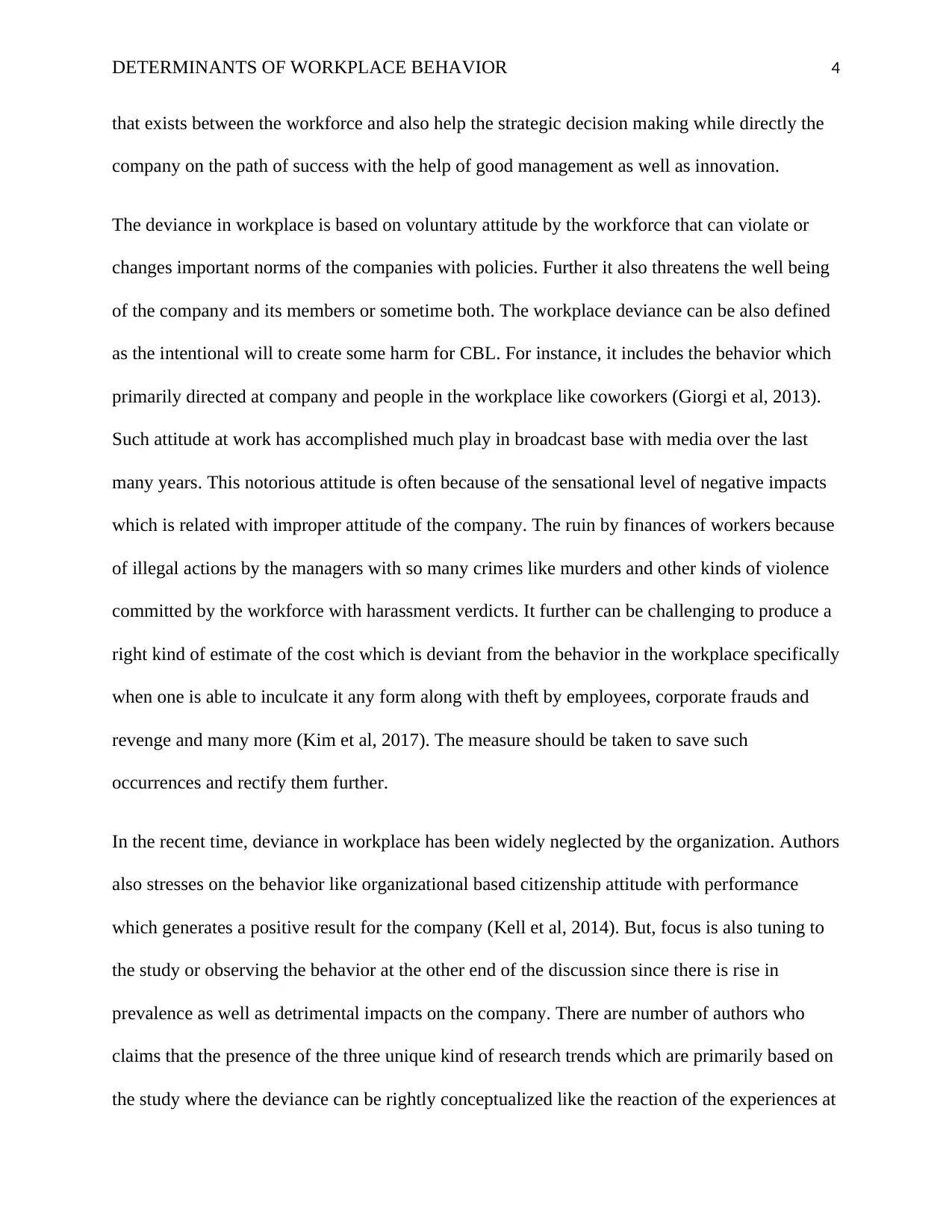
DETERMINANTS OF WORKPLACE BEHAVIOR 4
that exists between the workforce and also help the strategic decision making while directly the
company on the path of success with the help of good management as well as innovation.
The deviance in workplace is based on voluntary attitude by the workforce that can violate or
changes important norms of the companies with policies. Further it also threatens the well being
of the company and its members or sometime both. The workplace deviance can be also defined
as the intentional will to create some harm for CBL. For instance, it includes the behavior which
primarily directed at company and people in the workplace like coworkers (Giorgi et al, 2013).
Such attitude at work has accomplished much play in broadcast base with media over the last
many years. This notorious attitude is often because of the sensational level of negative impacts
which is related with improper attitude of the company. The ruin by finances of workers because
of illegal actions by the managers with so many crimes like murders and other kinds of violence
committed by the workforce with harassment verdicts. It further can be challenging to produce a
right kind of estimate of the cost which is deviant from the behavior in the workplace specifically
when one is able to inculcate it any form along with theft by employees, corporate frauds and
revenge and many more (Kim et al, 2017). The measure should be taken to save such
occurrences and rectify them further.
In the recent time, deviance in workplace has been widely neglected by the organization. Authors
also stresses on the behavior like organizational based citizenship attitude with performance
which generates a positive result for the company (Kell et al, 2014). But, focus is also tuning to
the study or observing the behavior at the other end of the discussion since there is rise in
prevalence as well as detrimental impacts on the company. There are number of authors who
claims that the presence of the three unique kind of research trends which are primarily based on
the study where the deviance can be rightly conceptualized like the reaction of the experiences at
that exists between the workforce and also help the strategic decision making while directly the
company on the path of success with the help of good management as well as innovation.
The deviance in workplace is based on voluntary attitude by the workforce that can violate or
changes important norms of the companies with policies. Further it also threatens the well being
of the company and its members or sometime both. The workplace deviance can be also defined
as the intentional will to create some harm for CBL. For instance, it includes the behavior which
primarily directed at company and people in the workplace like coworkers (Giorgi et al, 2013).
Such attitude at work has accomplished much play in broadcast base with media over the last
many years. This notorious attitude is often because of the sensational level of negative impacts
which is related with improper attitude of the company. The ruin by finances of workers because
of illegal actions by the managers with so many crimes like murders and other kinds of violence
committed by the workforce with harassment verdicts. It further can be challenging to produce a
right kind of estimate of the cost which is deviant from the behavior in the workplace specifically
when one is able to inculcate it any form along with theft by employees, corporate frauds and
revenge and many more (Kim et al, 2017). The measure should be taken to save such
occurrences and rectify them further.
In the recent time, deviance in workplace has been widely neglected by the organization. Authors
also stresses on the behavior like organizational based citizenship attitude with performance
which generates a positive result for the company (Kell et al, 2014). But, focus is also tuning to
the study or observing the behavior at the other end of the discussion since there is rise in
prevalence as well as detrimental impacts on the company. There are number of authors who
claims that the presence of the three unique kind of research trends which are primarily based on
the study where the deviance can be rightly conceptualized like the reaction of the experiences at
Paraphrase This Document
Need a fresh take? Get an instant paraphrase of this document with our AI Paraphraser
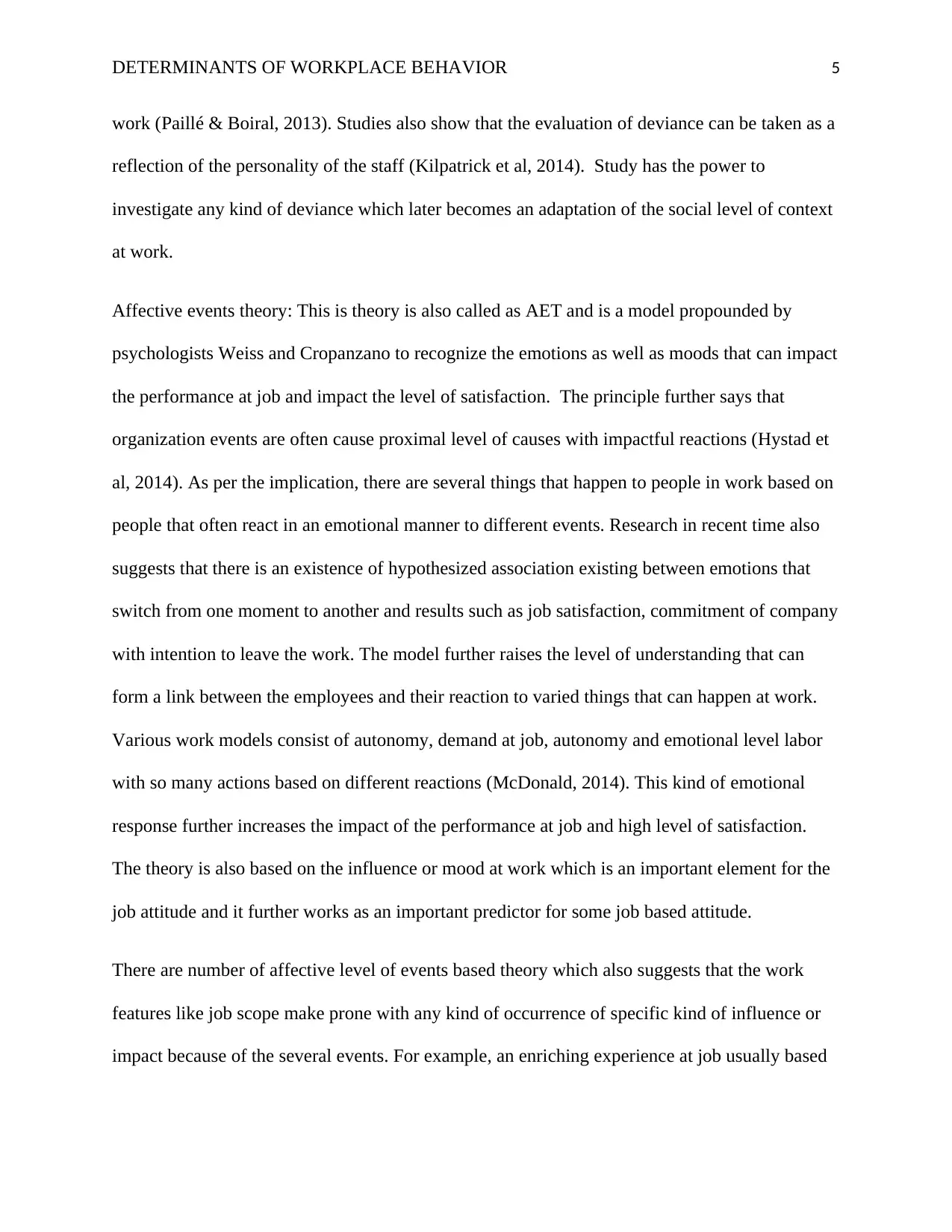
DETERMINANTS OF WORKPLACE BEHAVIOR 5
work (Paillé & Boiral, 2013). Studies also show that the evaluation of deviance can be taken as a
reflection of the personality of the staff (Kilpatrick et al, 2014). Study has the power to
investigate any kind of deviance which later becomes an adaptation of the social level of context
at work.
Affective events theory: This is theory is also called as AET and is a model propounded by
psychologists Weiss and Cropanzano to recognize the emotions as well as moods that can impact
the performance at job and impact the level of satisfaction. The principle further says that
organization events are often cause proximal level of causes with impactful reactions (Hystad et
al, 2014). As per the implication, there are several things that happen to people in work based on
people that often react in an emotional manner to different events. Research in recent time also
suggests that there is an existence of hypothesized association existing between emotions that
switch from one moment to another and results such as job satisfaction, commitment of company
with intention to leave the work. The model further raises the level of understanding that can
form a link between the employees and their reaction to varied things that can happen at work.
Various work models consist of autonomy, demand at job, autonomy and emotional level labor
with so many actions based on different reactions (McDonald, 2014). This kind of emotional
response further increases the impact of the performance at job and high level of satisfaction.
The theory is also based on the influence or mood at work which is an important element for the
job attitude and it further works as an important predictor for some job based attitude.
There are number of affective level of events based theory which also suggests that the work
features like job scope make prone with any kind of occurrence of specific kind of influence or
impact because of the several events. For example, an enriching experience at job usually based
work (Paillé & Boiral, 2013). Studies also show that the evaluation of deviance can be taken as a
reflection of the personality of the staff (Kilpatrick et al, 2014). Study has the power to
investigate any kind of deviance which later becomes an adaptation of the social level of context
at work.
Affective events theory: This is theory is also called as AET and is a model propounded by
psychologists Weiss and Cropanzano to recognize the emotions as well as moods that can impact
the performance at job and impact the level of satisfaction. The principle further says that
organization events are often cause proximal level of causes with impactful reactions (Hystad et
al, 2014). As per the implication, there are several things that happen to people in work based on
people that often react in an emotional manner to different events. Research in recent time also
suggests that there is an existence of hypothesized association existing between emotions that
switch from one moment to another and results such as job satisfaction, commitment of company
with intention to leave the work. The model further raises the level of understanding that can
form a link between the employees and their reaction to varied things that can happen at work.
Various work models consist of autonomy, demand at job, autonomy and emotional level labor
with so many actions based on different reactions (McDonald, 2014). This kind of emotional
response further increases the impact of the performance at job and high level of satisfaction.
The theory is also based on the influence or mood at work which is an important element for the
job attitude and it further works as an important predictor for some job based attitude.
There are number of affective level of events based theory which also suggests that the work
features like job scope make prone with any kind of occurrence of specific kind of influence or
impact because of the several events. For example, an enriching experience at job usually based
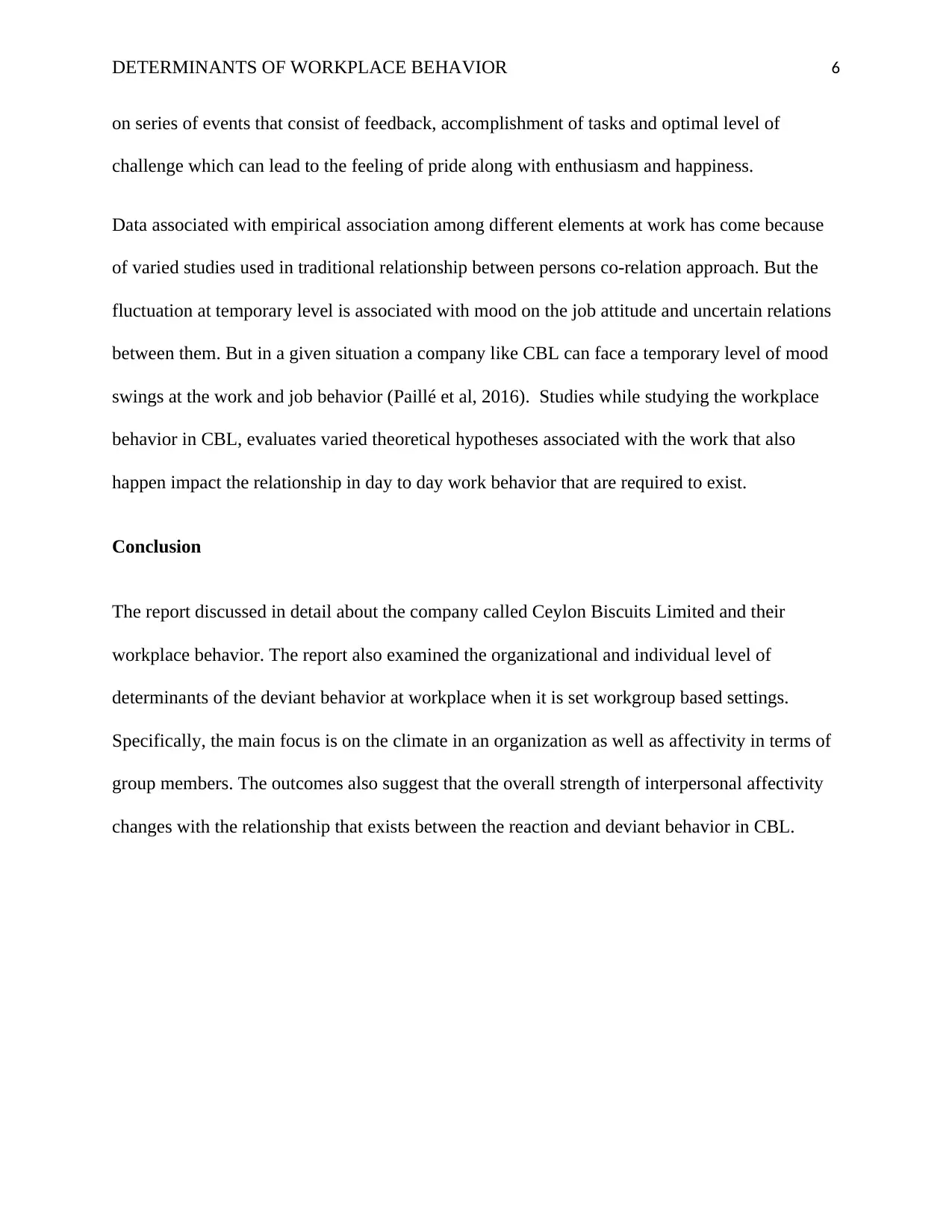
DETERMINANTS OF WORKPLACE BEHAVIOR 6
on series of events that consist of feedback, accomplishment of tasks and optimal level of
challenge which can lead to the feeling of pride along with enthusiasm and happiness.
Data associated with empirical association among different elements at work has come because
of varied studies used in traditional relationship between persons co-relation approach. But the
fluctuation at temporary level is associated with mood on the job attitude and uncertain relations
between them. But in a given situation a company like CBL can face a temporary level of mood
swings at the work and job behavior (Paillé et al, 2016). Studies while studying the workplace
behavior in CBL, evaluates varied theoretical hypotheses associated with the work that also
happen impact the relationship in day to day work behavior that are required to exist.
Conclusion
The report discussed in detail about the company called Ceylon Biscuits Limited and their
workplace behavior. The report also examined the organizational and individual level of
determinants of the deviant behavior at workplace when it is set workgroup based settings.
Specifically, the main focus is on the climate in an organization as well as affectivity in terms of
group members. The outcomes also suggest that the overall strength of interpersonal affectivity
changes with the relationship that exists between the reaction and deviant behavior in CBL.
on series of events that consist of feedback, accomplishment of tasks and optimal level of
challenge which can lead to the feeling of pride along with enthusiasm and happiness.
Data associated with empirical association among different elements at work has come because
of varied studies used in traditional relationship between persons co-relation approach. But the
fluctuation at temporary level is associated with mood on the job attitude and uncertain relations
between them. But in a given situation a company like CBL can face a temporary level of mood
swings at the work and job behavior (Paillé et al, 2016). Studies while studying the workplace
behavior in CBL, evaluates varied theoretical hypotheses associated with the work that also
happen impact the relationship in day to day work behavior that are required to exist.
Conclusion
The report discussed in detail about the company called Ceylon Biscuits Limited and their
workplace behavior. The report also examined the organizational and individual level of
determinants of the deviant behavior at workplace when it is set workgroup based settings.
Specifically, the main focus is on the climate in an organization as well as affectivity in terms of
group members. The outcomes also suggest that the overall strength of interpersonal affectivity
changes with the relationship that exists between the reaction and deviant behavior in CBL.
⊘ This is a preview!⊘
Do you want full access?
Subscribe today to unlock all pages.

Trusted by 1+ million students worldwide
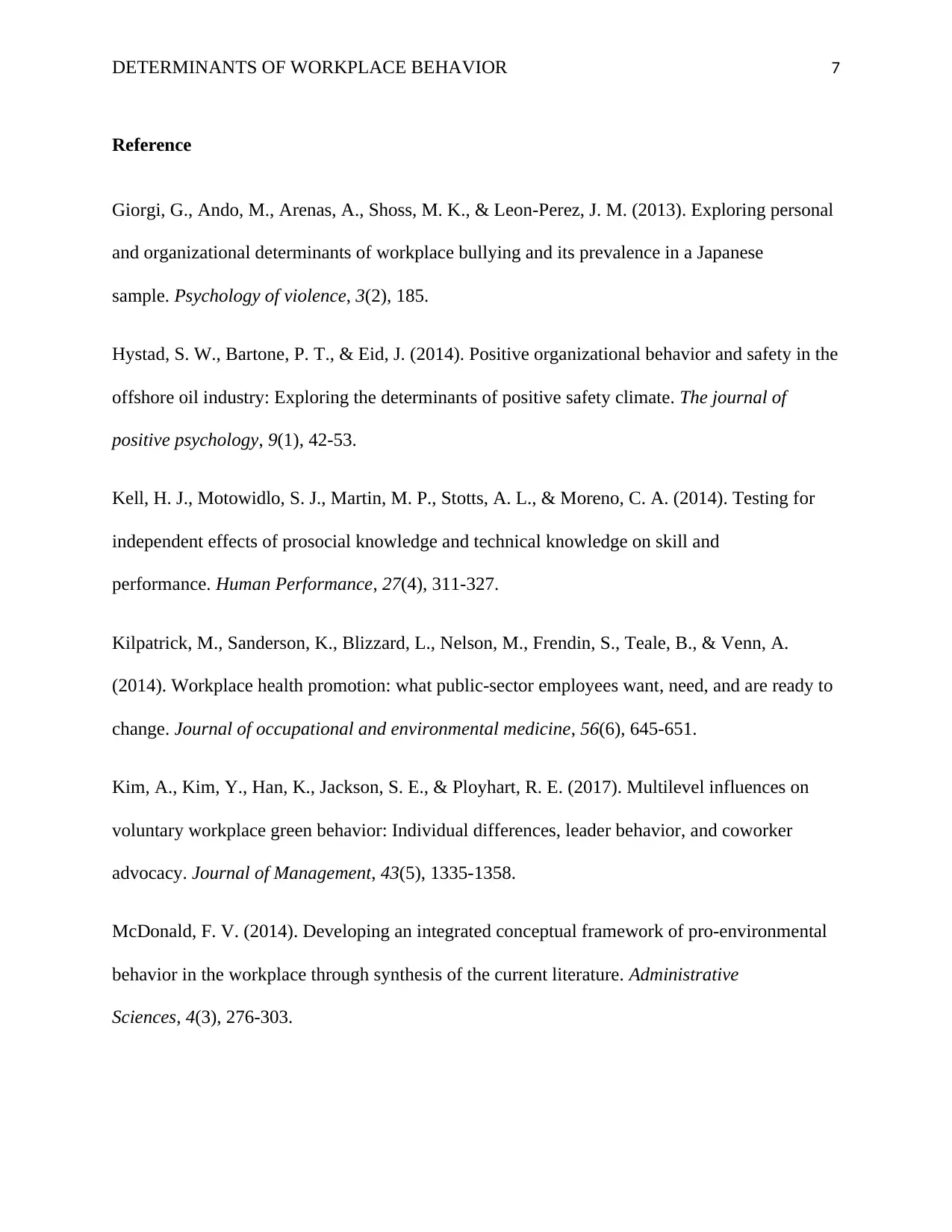
DETERMINANTS OF WORKPLACE BEHAVIOR 7
Reference
Giorgi, G., Ando, M., Arenas, A., Shoss, M. K., & Leon-Perez, J. M. (2013). Exploring personal
and organizational determinants of workplace bullying and its prevalence in a Japanese
sample. Psychology of violence, 3(2), 185.
Hystad, S. W., Bartone, P. T., & Eid, J. (2014). Positive organizational behavior and safety in the
offshore oil industry: Exploring the determinants of positive safety climate. The journal of
positive psychology, 9(1), 42-53.
Kell, H. J., Motowidlo, S. J., Martin, M. P., Stotts, A. L., & Moreno, C. A. (2014). Testing for
independent effects of prosocial knowledge and technical knowledge on skill and
performance. Human Performance, 27(4), 311-327.
Kilpatrick, M., Sanderson, K., Blizzard, L., Nelson, M., Frendin, S., Teale, B., & Venn, A.
(2014). Workplace health promotion: what public-sector employees want, need, and are ready to
change. Journal of occupational and environmental medicine, 56(6), 645-651.
Kim, A., Kim, Y., Han, K., Jackson, S. E., & Ployhart, R. E. (2017). Multilevel influences on
voluntary workplace green behavior: Individual differences, leader behavior, and coworker
advocacy. Journal of Management, 43(5), 1335-1358.
McDonald, F. V. (2014). Developing an integrated conceptual framework of pro-environmental
behavior in the workplace through synthesis of the current literature. Administrative
Sciences, 4(3), 276-303.
Reference
Giorgi, G., Ando, M., Arenas, A., Shoss, M. K., & Leon-Perez, J. M. (2013). Exploring personal
and organizational determinants of workplace bullying and its prevalence in a Japanese
sample. Psychology of violence, 3(2), 185.
Hystad, S. W., Bartone, P. T., & Eid, J. (2014). Positive organizational behavior and safety in the
offshore oil industry: Exploring the determinants of positive safety climate. The journal of
positive psychology, 9(1), 42-53.
Kell, H. J., Motowidlo, S. J., Martin, M. P., Stotts, A. L., & Moreno, C. A. (2014). Testing for
independent effects of prosocial knowledge and technical knowledge on skill and
performance. Human Performance, 27(4), 311-327.
Kilpatrick, M., Sanderson, K., Blizzard, L., Nelson, M., Frendin, S., Teale, B., & Venn, A.
(2014). Workplace health promotion: what public-sector employees want, need, and are ready to
change. Journal of occupational and environmental medicine, 56(6), 645-651.
Kim, A., Kim, Y., Han, K., Jackson, S. E., & Ployhart, R. E. (2017). Multilevel influences on
voluntary workplace green behavior: Individual differences, leader behavior, and coworker
advocacy. Journal of Management, 43(5), 1335-1358.
McDonald, F. V. (2014). Developing an integrated conceptual framework of pro-environmental
behavior in the workplace through synthesis of the current literature. Administrative
Sciences, 4(3), 276-303.
Paraphrase This Document
Need a fresh take? Get an instant paraphrase of this document with our AI Paraphraser
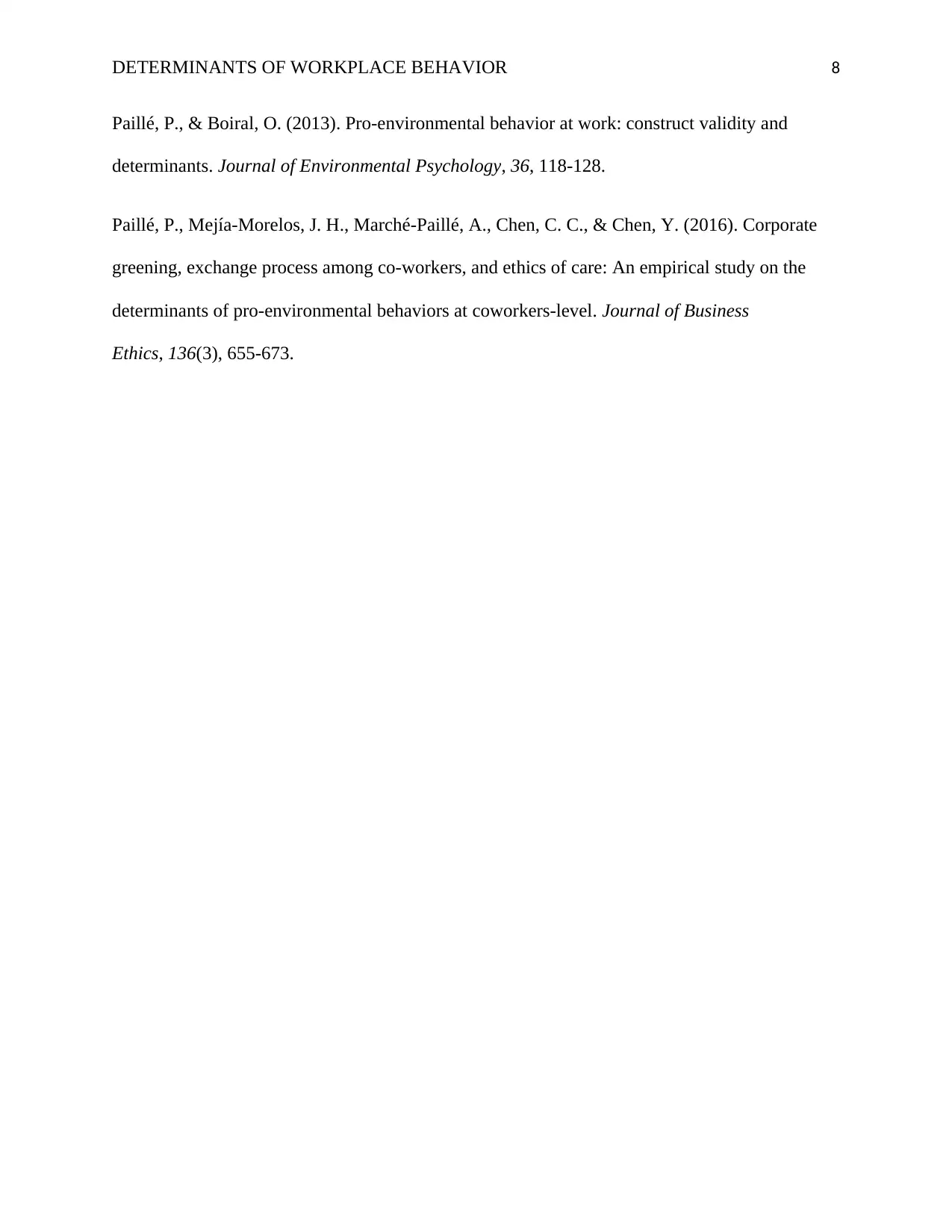
DETERMINANTS OF WORKPLACE BEHAVIOR 8
Paillé, P., & Boiral, O. (2013). Pro-environmental behavior at work: construct validity and
determinants. Journal of Environmental Psychology, 36, 118-128.
Paillé, P., Mejía-Morelos, J. H., Marché-Paillé, A., Chen, C. C., & Chen, Y. (2016). Corporate
greening, exchange process among co-workers, and ethics of care: An empirical study on the
determinants of pro-environmental behaviors at coworkers-level. Journal of Business
Ethics, 136(3), 655-673.
Paillé, P., & Boiral, O. (2013). Pro-environmental behavior at work: construct validity and
determinants. Journal of Environmental Psychology, 36, 118-128.
Paillé, P., Mejía-Morelos, J. H., Marché-Paillé, A., Chen, C. C., & Chen, Y. (2016). Corporate
greening, exchange process among co-workers, and ethics of care: An empirical study on the
determinants of pro-environmental behaviors at coworkers-level. Journal of Business
Ethics, 136(3), 655-673.
1 out of 8
Related Documents
Your All-in-One AI-Powered Toolkit for Academic Success.
+13062052269
info@desklib.com
Available 24*7 on WhatsApp / Email
![[object Object]](/_next/static/media/star-bottom.7253800d.svg)
Unlock your academic potential
Copyright © 2020–2025 A2Z Services. All Rights Reserved. Developed and managed by ZUCOL.





